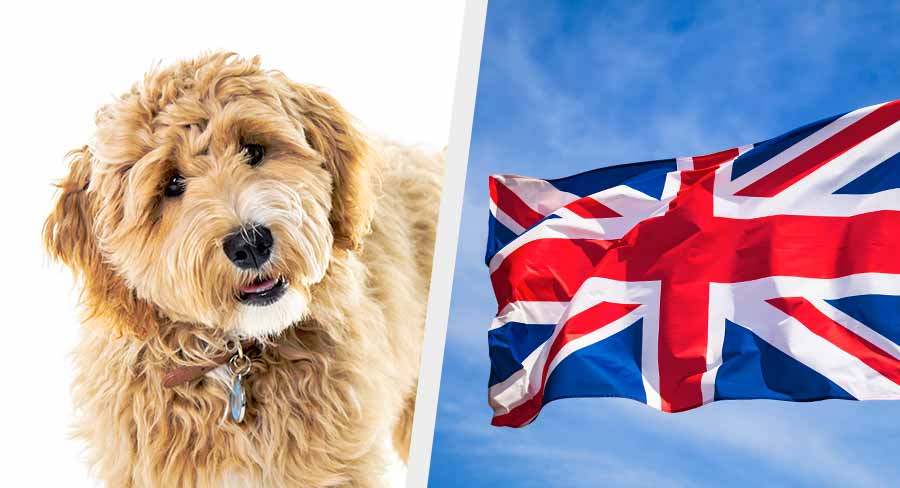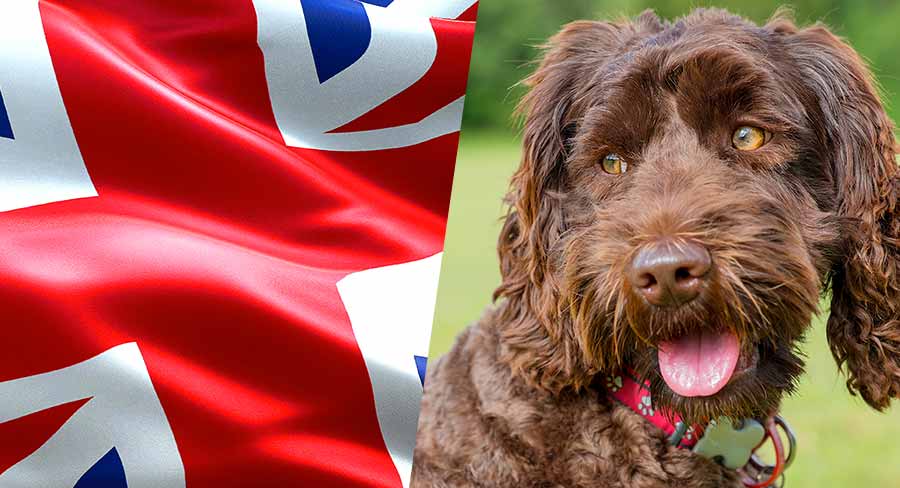This guide to the English Labradoodle explains what sets them apart from other types of Labradoodles. And how to tell if one is the right pet for you.
English Labradoodle usually means a Labradoodle whose Labrador parent came from show lines, and who met a particular physical ideal. Being of show type – also known as English type – is sometimes associated with a particular kind of temperament too. This temperament may be passed onto English Labradoodle puppies.
What Is An English Labradoodle?
If someone tells you they have an English Labradoodle, they could just mean they have a Labradoodle from England. This is most likely if they themselves have relocated from England. They might also have heard people talk about Australian Labradoodles, and formed the impression that it’s standard convention to give your Labradoodle’s country of origin when you introduce them.
But it’s more likely that they mean their Labradoodle has an English Labrador parent. English Labradors are not necessarily Labradors from England. They are Labs from particular breeding lines, which match a particular type. They are also known as show-type, or bench-type Labradors, because they are bred for the purpose of being highly suitable to enter dog shows.
English Labradoodle Appearance
English Labradors are notable for being more heavy set and broader looking than their working cousins. Especially in their face, which tends to be slightly wider and more blocky than that of an American Labrador (also known as working type, and having little to do with nationality). Their muzzle is frequently a little shorter too, and the stop (the point where the muzzle meets the forehead) is more pronounced. English Labradors also tend to cluster at the bottom of the natural Labrador height range, but at the top of the range for weight. Finally, they’re more likely to have the traditional otter tail. Otter tails start wide at the base and taper to a point. Many working Labs now have a tail which is slender all the way down instead.

An English Labradoodle can also inherit some of the traditional English Labrador traits. So they may be shorter, more heavy set, and have a more Labrador-like face than a Labradoodle with an American Lab parent. English Labrador physique is very different from Poodle physique, so there’s also lots of potential for variety in English Labradoodle appearance. The svelte and agile-looking American Lab starts off closer to the Poodle in build, so their puppies will tend to look more like they all came from the same mould.
English Labradoodle Traits
What about temperament? Well, English Labrador personality is also slightly distinct from American Labrador personality. Conformation shows judge entrants on their appearance, rather than their working ability, and this has affected English Labrador temperament too. For a start, there’s less pressure on them to be extremely intelligent, or highly motivated workers. Or to come equipped with endless physical and mental stamina. In fact, it helps if they have quite laid back temperaments, and patiently tolerate long periods of waiting for the next thing to happen.
An English Labradoodle may have a very similar temperament. They are more likely to do so than a Labradoodle from working Labrador lines. But, they can also inherit some (or many) traits from their Poodle parent. Poodles are clever and active. They have a long history of working as gundogs and circus dogs, and they are regarded as being amongst the quickest breeds in the world at learning new commands. An English Labradoodle with these traits will be far from placid!
English Labradoodle Health
Unfortunately, very few studies of Labrador health distinguish between whether the subjects were English or American Labs. So it’s difficult to say whether an English Labradoodle’s health is likely to be significantly different from a Labradoodle with American Lab ancestry.
Generally, the health problems Labradors are most prone to are:
- Joint diseases. Particularly hip and elbow dysplasia.
- Obesity. Labradors are the only breed known to carry a specific genetic mutation which causes excessive appetite.
- Ear infections. Their heavy, hanging ears, coupled with their love of swimming is a recipe for infections of pesky bacteria which love the warm, moist environment inside their ears.
- Atopic dermatitis. An itchy skin rash caused by an allergic reaction to something in their environment.
- And thyroid disease.
Poodles are also prone to hip and elbow dysplasia, thyroid disease, and problems associated with sensitive skin.
English Labradoodles are vulnerable to all the health concerns of their parents. So it’s important to choose puppies from parents who have been screened for hip and elbow disease, and thyroid disease. And who have no family history of allergies or itchy skin problems.
English Labradoodle Care
Since English Labs have a reputation for being calmer than American Labs, lots of people are interested in English Labradoodles because they hope they will be easier pets. However, the differences between English and American Labradors are relative. All Labs still need lots of exercise and mental stimulation every day! And Poodles also need lots of engagement and opportunities to burn off physical energy. So an English Labradoodle will still require several hours of attention every day.
Besides training and exercise, you’ll also need to consider grooming. The typical English Labrador’s coat is especially luxurious and dense. All the better for impressing show judges! This can make them an appealing prospect for Labradoodle breeding. What could be cuter than an English teddy bear Labradoodle with a super snuggly coat? But bear in mind an English Labradoodle’s coat can be curly and non-shedding like a Poodle’s or shorter and shed heavily like a Lab’s. In which case they are likely to shed copiously.
Finding An English Labradoodle For Sale
A responsible English Labradoodle breeder should know whether their litter’s Labrador parent comes from English or American breeding lines. And they should be able to tell you exactly why they chose that particular Labrador, and what makes them so great. If they don’t know what type the Labrador parent is, then you may be able to deduce it from their pedigree certificate. Ancestors with CCH before their kennel club name were bench show champions – English type Labs. Dogs with AFC, CFC, or GCF next to their name are all champion working dogs who likely belong to the American type.
If you’re looking for English Labradoodle puppies for sale, resist the urge to make English-type heritage your only priority. The most important thing should be finding puppies from health tested parents. Next, make sure each parent has a temperament you find attractive. Bear in mind that the differences between English and American Labs are generalisations. They have a lot in common too, and sometimes individuals go against type!

English Labradoodle vs American Labradoodle
American Labradoodles tend to be Labradoodles with a Labrador parent that belongs to the American type. American Labradors are also known as working or field Labradors. In contrast to English Labradors breeding lines where the focus is on producing patient dogs who look ‘perfect’, American Labradors are bred to be exceptional working dogs.
Their temperament is likely to be more active, and always on the go. They are even quicker to train, and learn complex commands more easily than English Labs. As a result of their energy and work ethic, they are also more likely to display frustrated or anxious behaviors if they don’t get enough exercise and mental stimulation. An American Labradoodle is likely to also be more energetic and harder to tire out than an English Labradoodle.
American and English Labradors are physically slightly different too. American Labs tend to be slightly taller, and of more slender build. More closely matched to the Poodle in fact! So, the build of American Labradoodles is likely to vary less than that of English Labradoodles.
English Labradoodle vs Australian Labradoodle
In contrast, Australian Labradoodles aren’t bred from a specific type of Labrador (or Poodle). Australian Labradoodle is the breed name chosen by Labradoodle breeders who wish to see the Labradoodle recognized as a new breed in its own right. The breeding programme to achieve this has been underway since the 1990s. Most Australian Labradoodles are now bred from other Australian Labradoodles. Like German Shepherds, they don’t have to be bred in their namesake country anymore!
The purpose of standardizing Australian Labradoodles is to create breeding lines which have reliably predictable looks and temperaments. Being first generation crosses, English Labradoodles are inevitably more variable in appearance and personality than Australian Labradoodles. Genetic analysis of Australian Poodles also suggests that breeders have selected strongly in favor of Poodle traits over Labrador traits. So an Australian Poodle is likely to be very Poodle-like in many ways. Whereas a litter of English Labradoodle puppies could have individuals that are very Labrador-like.
English Labradoodle Summary
If someone refers to an English Labradoodle, they could mean a Labradoodle from England. Or they could mean a Labradoodle whose Labrador parent is of the English type. The most straightforward way to find out which is to ask them what English Labradoodle means! People typically love talking about their dogs, and enjoy any opportunity to talk about them.
Do you have an English Labradoodle puppy? Or even an old English Labradoodle? Please tell us more about them in the comments box down below!
Before you go
You’ll also enjoy these articles, about other Labradoodle types:
- Australian Vs American Labradoodle
- Wirehaired Labradoodle Puppy
- F2 Labradoodle – What Does It Mean?
- Multigenerational Labradoodle
- Apricot Labradoodle
References
Ali et al. Genetic analysis of the modern Australian labradoodle dog breed reveals an excess of the poodle genome. PLoS Genetics. 2020.
Lofgren et al. Management and personality in Labrador Retriever dogs. Applied Animal Behavior Science. 2014.
McGreevy et al. Labrador retrievers under primary veterinary care in the UK: demography, mortality and disorders. Canine Medicine & Genetics. 2018.
Pugh et al. Dogslife: A cohort study of Labrador Retriever Health. Society of Veterinary Epidemiology and Preventive Medicine Conference. 2015.
Mankowska et al. Confirmation that a deletion in the POMC gene is associated with body weight of Labrador Retriever dogs. Research in Veterinary Science. 2017.
Shaw et al. Estimation of heritability of atopic dermatitis in Labrador and Golden Retrievers. Journal of the American Veterinary Medical Association. 2004.

